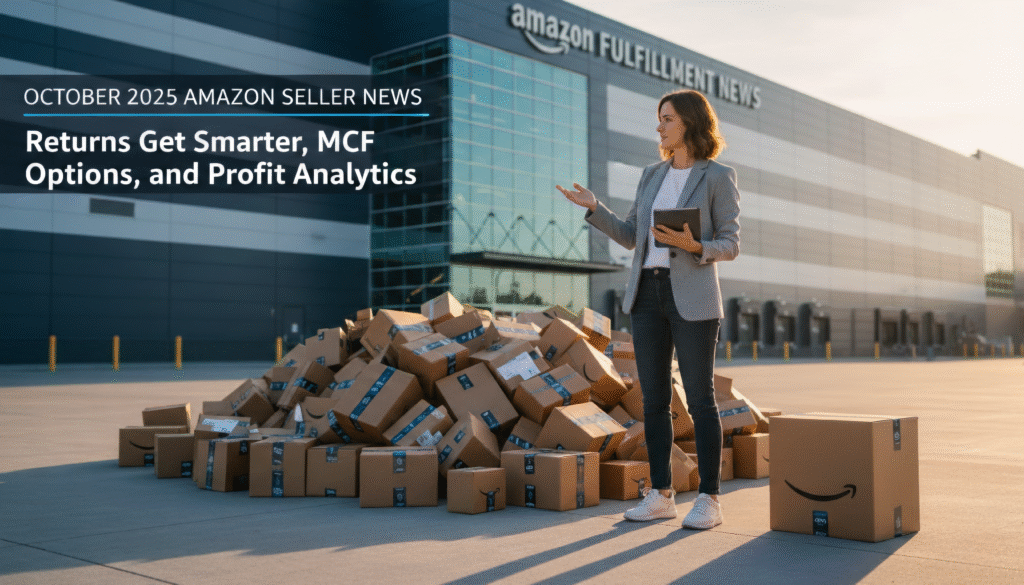Amazon Seller News: Returns get smarter, Alexa grows up, and a few tools worth testing

If you sell on Amazon, the last few weeks brought useful changes you can act on. Here are the ones that matter most, why they matter, and the quick moves to make.
1. “Refund and keep it” lands for select FBA returns
Amazon’s FBA Partial Refunds lets eligible customers accept a partial refund without shipping the product back. It cuts reverse‑logistics costs and speeds resolution for low‑value or bulky items.
When to use it: low ASP accessories, cosmetic or packaging damage, and anything where return shipping costs more than the item is worth. Enable it at the ASIN level and track outcomes in your returns views.
2. New visibility on why customers return your items
The Returns & Recovery: Insights and Opportunities dashboard pulls FBA and FBM returns into one place, surfaces top reasons, and shows recovery paths like restock, refurbish, liquidate, or donate. Pair it with Voice of the Customer to align listing fixes with real return drivers.
Quick win: sort by most‑returned SKUs, then update the top 3 listings where images or bullets don’t match what customers expected.
3. Alexa+ gets real, with new shopping surfaces
Amazon rolled out Alexa+ and four new Echo devices that make discovery more conversational. See the device lineup here and Alexa+ details here.
- Add natural phrases to bullets and A+ that mirror what a shopper would say out loud.
- Bundle complementary items so voice suggestions can connect the dots on “complete the setup.”
4. Heads up on payouts: DD+7 reserve migration
Amazon is moving accounts to payments based on delivery date. The help page explains the standard seven‑day reserve after delivery here. Seller notices indicate a broad migration to DD+7 beginning March 12, 2026.
What to do: update your cash‑flow plan for a post‑delivery seven‑day lag and review Deferred transactions in Payments so finance can reconcile timing cleanly.
5. Image Manager transparency
Image Manager now labels images as Live or Not live and shows the source when your image isn’t what renders on the PDP. See the forum announcement and upload guidance.
Fast audit: review top ASINs in Image Manager and fix any off‑brand hero images first.
6. Shoppable A+ and Store product collections
Shoppable Basic A+ modules let customers add to cart from the comparison chart. In your Brand Store, the Product collections tile groups up to 60 ASINs with a lifestyle image and auto‑hides OOS items.
Playbook: turn your Brand Story into a cross‑sell moment on the PDP, then mirror those families as Store collections.
7. Profit Analytics for SKU‑level decisions
Amazon introduced Profit Analytics to consolidate revenue, fees, ads, returns, and even off‑Amazon costs so you can see true margins without spreadsheet gymnastics. The SKU economics report is a useful companion for historical unit economics.
8. B2B fee relief if you price for bulk
Offer at least a 3% business price or quantity discount and Amazon Business will reduce referral fees on qualifying large orders. Details are in the help doc.
9. MCF opens up to Walmart, Shopify, and Shein
Amazon expanded Multi‑Channel Fulfillment so you can fulfill Walmart Marketplace and Shopify orders from FBA inventory, with Shein support following. See Amazon’s press note for more details.
Reality check: run landed‑cost math before consolidating inventory. Faster delivery helps conversion only if fees pencil out.
One regulatory note worth knowing
The FTC announced a $2.5B Prime settlement requiring consumer refunds and clearer sign‑up and cancellation flows. Cleaner flows usually reduce support friction and complaints that can spill into reviews.
5‑minute checklist for this week
- Trial FBA Partial Refunds on 3 to 5 SKUs where inbound shipping is wasteful.
- Open the Returns & Recovery dashboard and fix one top driver on a high‑volume ASIN.
- Use Image Manager to align your hero images with what’s actually live.
- Build a cash‑flow buffer for DD+7.
- Turn on Profit Analytics and schedule a weekly margin review.
- If you sell B2B, set a ≥3% business price or quantity discount to unlock fee reductions.
- If you sell off‑Amazon, pilot MCF on your top 10 SKUs where faster delivery drives conversion. Start with Shopify or Walmart.
